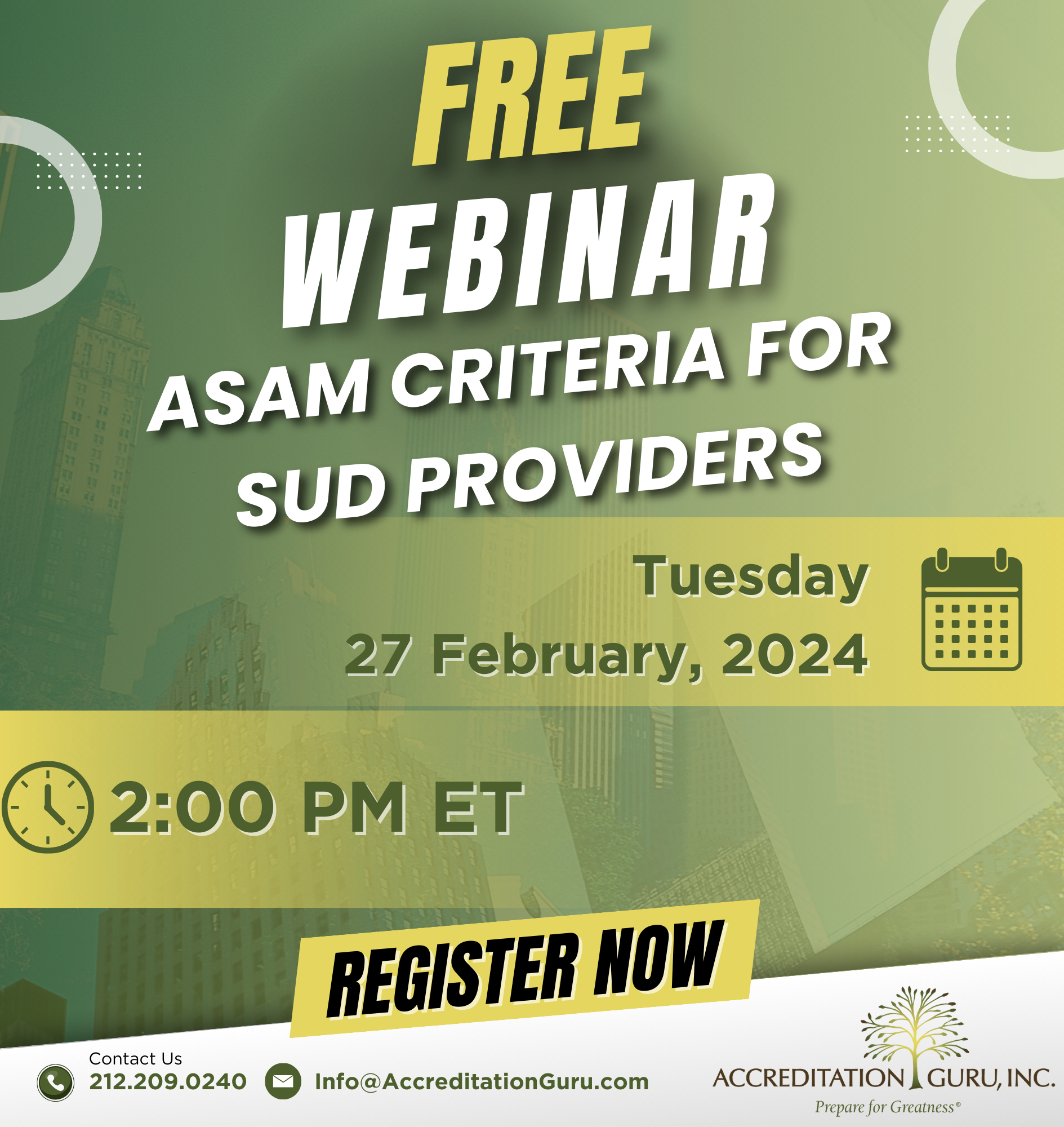Accreditation isn’t just a badge of honor—it’s a key factor influencing insurance coverage across industries. From healthcare to education, accreditation status can make a significant impact on the breadth of coverage and premiums insurers offer.
ASAM Criteria: Paving the Path to Recovery
In the ever-evolving landscape of addiction treatment, staying abreast of the latest advancements and guidelines is paramount to ensuring the highest quality of treatment. The American Society of Addiction Medicine (ASAM) stands at the forefront of this mission, providing comprehensive framework through its Criteria. This set of guidelines has become the gold standard in addiction medicine, shaping the way professionals approach assessment, treatment planning, and ongoing care.
The 6 Dimensions of Care
The ASAM’s Criteria is a dynamic and adaptable tool designed to assist healthcare professionals in providing personalized, patient-centered care for individuals struggling with addiction. The criteria encompass six dimensions, each crucial in capturing the complexity of addiction and guiding comprehensive treatment plans. In December of 2023, ASAM released its 4th Edition, which included updates to these six dimensions. They are:
- Intoxication, Withdrawal, and Addiction Medications
- Biomedical Conditions
- Psychiatric and Cognitive Conditions
- Substance Use-Related Risks
- Recovery Environment Interactions
- Person-Centered Consideration
These dimensions are used to determine which level of care is appropriate for each client. Recommendations for the level of care and treatment plans are crafted through comprehensive patient assessments, which take into account the patient’s biomedical, psychological, and social requirements.
ASAM’s Growing Popularity
The ascendancy of ASAM compliance in the realm of addiction treatment is not merely a passing trend but a paradigm shift that reflects a broader movement toward evidence-based, patient-centered care. As the prevalence of substance use disorders continues to rise, fueled by myriad social, economic, and environmental factors, the need for standardized, effective approaches to addiction treatment has never been more pressing. Against this backdrop, ASAM compliance offers a roadmap to guide both clinicians and patients towards the promise of recovery for several compelling reasons.
Standardization and Quality Assurance:
ASAM compliance establishes a standardized framework for assessing and treating individuals with substance use disorders. By adhering to these Criteria, treatment providers ensure consistency and quality across all aspects of care delivery, from assessment and diagnosis to treatment planning and discharge. This standardization promotes accountability and quality assurance, instilling confidence in patients, families, and referring professionals regarding the effectiveness and reliability of addiction treatment services.
Alignment with Evidence-Based Practices:
ASAM Criteria reflect the latest advancements in addiction medicine and behavioral healthcare. Compliance with their guidelines ensures that treatment providers are utilizing interventions and approaches that have been rigorously researched and validated for their effectiveness in addressing substance use disorders. This alignment with evidence-based practices enhances treatment outcomes and increases the likelihood of successful recovery.
Improved Communication and Collaboration:
When healthcare providers, treatment facilities, and other stakeholders involved in the continuum of care are following the same criteria, this fosters enhanced communication and collaboration. By utilizing a common language and framework for assessment and treatment planning, providers can more coordinate with one another across different levels and settings. This interdisciplinary collaboration ensures that individuals receive comprehensive, holistic care that addresses their unique needs and promotes long-term recovery.
Regulatory Requirements and Accreditation Standards:
Many regulatory agencies and accrediting bodies require compliance with ASAM Criteria as part of their licensing and accreditation standards for addiction treatment facilities. Meeting these requirements demonstrates a commitment to maintaining high standards of care and adherence to best practices in addiction treatment. Compliance with ASAM guidelines can also help treatment facilities navigate the regulatory landscape more effectively and avoid potential legal and financial risks associated with non-compliance.
Enhanced Patient-Centered Care:
These Criteria prioritize a patient-centered approach to addiction treatment, focusing on the individual’s unique needs, strengths, and preferences. By conducting comprehensive assessments and tailoring treatment plans to meet the specific needs of each patient, treatment providers can deliver more personalized and effective care that resonates with the individual’s goals and values. This patient-centered approach fosters greater engagement, empowerment, and satisfaction among those who seek treatment for substance use disorders.
When a treatment facility embraces the standardized framework of ASAM Criteria, they are offered a multitude of benefits. Their outcomes are improved, treatment plans are enhanced, the allocation of resources is optimized, and the decision-making of their patients becomes empowered. This is not merely a set of rules and regulations, but a path that holds transformative potential for the lives of individuals and communities affected by addiction. It represents a convergence of best practices, regulatory standards, and patient-centered principles that pave the way towards interdisciplinary cooperation and mutual support. By aligning with ASAM’s guidelines, treatment providers can enhance the quality, effectiveness, and accessibility of addiction treatment services, ultimately improving outcomes and promoting recovery for their clients.
If you and your organization are looking to come into alignment with ASAM’s Criteria, we can help! Accreditation Guru offers assistance by providing crosswalks of your policies and procedures to ASAM, reviewing clinical records for accurate documentation of ASAM Criteria clinical processes, and more. Click here to schedule a free Zoom consultation with us so we can further discuss your unique needs.
ASAM Criteria for SUD Providers
Dive into the intricacies of the American Society of Addiction Medicine (ASAM) Criteria on Substance Use Disorder (SUD) treatment in our focused webinar designed for healthcare administrators and professionals, counselors, and therapists. This course offers a comprehensive exploration of advanced strategies crucial in elevating SUD care and treatment efficacy.
Discussions will include the Multi-dimensional Biopsychosocial Assessment, emphasizing the interplay between biological, psychological, and social factors in SUD and a segment on Person-centered, Individualized Treatment Planning. Determining your program(s) ASAM Level of Care (LOC) Placement is critical for all SUD treatment providers, and we will explore ASAM criteria for accurately assessing LOC and matching patient needs with appropriate services, as well as Multi-dimensional Discharge/Transfer Planning strategies.
Mention will be made of the importance of ASAM alignment for Medicaid and commercial insurances reimbursement.
Additionally, you will gain insights into CARF or Joint Commission Accreditation for SUD Providers, including navigating the accreditation process and maintaining compliance. Finally, we’ll explore the significance of ASAM LOC Certification by CARF in enhancing service delivery and treatment efficacy. Highlights will also be given to identify changes to the ASAM Criteria Dimension in the new Forth Edition.
Get Accredited Without Breaking the Bank
Human service organizations play a crucial role in meeting the needs of vulnerable populations, and it is essential that they are well-managed and effective in their operations. One way that organizations can demonstrate their commitment to quality is by becoming nationally accredited. However, the costs associated with accreditation can be a barrier for some organizations, especially those with limited resources.
While the costs of accreditation can be significant, it is important to remember that accreditation can lead to significant organizational improvements. Accreditation helps organizations to identify areas for improvement, implement best practices, and enhance their service delivery. These improvements can translate into better outcomes for clients and greater organization efficiency, which can help to offset the costs of accreditation over time.
Read on for tips on how a human service organization may approach the costs associated with becoming nationally accredited.
Direct vs. Indirect Costs
It is important to analyze the annual costs associated with accreditation and determine whether they are feasible for the organization. This analysis should include both direct costs (such as application fees and onsite survey expenses) and indirect costs (staff time spent on accreditation-related tasks or improvements to facilities, for example). By understanding the costs associated with accreditation, organizations can develop a realistic budget and plan accordingly.
TIP: When comparing fees from different accrediting bodies, they can vary widely based on your organization’s size, breadth of programs, number of locations, budget, etc. When you have an estimate of fees from an accrediting body (AB) for your entity, it helps to divide by three if that AB has a 3-year cycle (such as CARF International or The Joint Commission) or divide by four for a 4-year cycle (COA Accreditation, for example) to better directly compare total fees.
New Program Development & Expansion
New program development / expansion may come about as a decision while conducting strategic planning, assessing needs of defined service population, staffing needs, and accessibility of services. These decisions may require additional staffing, resources, and facilities improvements, which can add to the overall cost of accreditation. However, these investments can also help organizations to better serve their communities, enhance their long-term sustainability, and ultimately lead to higher revenue.
TIP: Be sure that your leadership and board of directors have accurate and complete data to make informed decisions. It may seem like this does not need to be said, but sometimes organizations want to paint a rosy picture of how things are going. Be honest, make hard decisions when needed, and be sure that you are serving the current needs of your defined service population.
Improved Operational Efficiencies
Accreditation helps an organization use its resources more efficiently and can result in cost savings. Accreditation requirements for clear and detailed written procedures based on well thought out policies can enhance staff performance, improve outcomes, and lead to better communication with, and satisfaction for, the clients. These efficiencies can help retain staff, strengthen relationships with funding and referral sources, and aid in compliance with state or federal regulatory bodies.
TIP: States recognize the positive impact of accreditation and many offer regulatory relief from licensing / certification requirements. Check with your state licensing or certification representative for recognitions of accreditation.
Liability Insurance
Accredited service providers may be eligible for considerations on their insurance policies. The reason is that insurance carriers understand achieving accreditation leads to more robust risk management and risk mitigation efforts, a focus on health and safety, corporate compliance, and ethical business practices. This can lead to lower liability insurance costs over time, which can help offset the initial costs of accreditation.
There is a reason that the first question after the demographics (name, address) on an insurance policy application is “Licensure and Accreditations.”
TIP: You will need to inquire about considerations related to accreditation. If your broker is, for some reason, not familiar with the many benefits of national accreditation, they should be educated on it (feel free to share this article).
Grant Opportunities
Two notes about grants. First, some foundations use accreditation as a qualifier to apply for a grant, while others may use accreditation as an internal selection criteria without formally stating it as a requirement. Why? Because foundations and other funders understand the benefits and importance of earning and maintaining accreditation.
Second, there are grant opportunities out there that can help offset the costs associated with accreditation. While you may not see grants specific to accreditation, many grants will cover some aspects of accreditation and / or fund ways to improve your service programs. The following are examples of areas addressed under accreditation, and a grant related to such can be earmarked to help defray costs:
- Technology and equipment improvements
- Strategic planning
- Quality management programs
- Capacity building
- Board development
TIP: The National Council of Nonprofits has a listing of grant research tools, including a listing of state associations of nonprofits, which provides links to state-specific grant databases and member discounts on grant research tools. https://www.councilofnonprofits.org/running-nonprofit/fundraising-and-resource-development/grant-research-tools. Also, Candid (formerly the Foundation Center) helps nonprofits find funders to support their work through their Foundation Directory (fee-based). https://candid.org
Facilities and Office Space
In some cases, organizations may need to make improvements to their facilities or office space in order to meet accreditation standards. This may require additional funding, which should be factored into the organization’s budget and fundraising plans.
TIP: Have someone other than the Facilities Manager do a walk-through of all residential and operational facilities to review against accreditation standards early on in the process. The “fresh eyes” approach can be very helpful, whether this is conducted by a staff member or an outside consultant.
Ensure Board & Leadership Buy-in
Finally, it is crucial to ensure that the organization’s board and leadership are fully committed to the accreditation process. This includes not only providing the necessary financial resources but also actively participating in the accreditation process and ensuring that the organization meets all of the necessary standards and requirements. Board and leadership buy-in are critical to the success of accreditation, and without this support, the accreditation process may be difficult to achieve or sustain.
Keep in mind, just because you do have board and leadership buy-in does not guarantee an easy road to accreditation, but if you do NOT have this buy-in, you are fairly definite to have problems along the way.
TIP: Meet with the leadership team and board of directors when first considering accreditation to discuss the benefits, accrediting body or bodies being considered, outline the timeline and process, review costs and allow them to ask questions, all with an eye toward building the all-important buy-in.
In conclusion, the decision to pursue accreditation is a significant one for any human service organization. While the costs of accreditation can be significant, they must be weighed against the benefits of improved service delivery, reduced liability risks, and increased organizational efficiency. By carefully considering the costs and benefits of accreditation, organizations can make an informed decision about whether accreditation is the right choice for them and ensure their long-term sustainability and success.
For more information or questions about the contents of this article, please write Peggy Lavin @ peggy@accreditationguru.com. This post contains original content and was written for Accreditation Guru, Inc. Use of this copy is permitted with credit and reference within the same body of copy to Accreditation Guru, Inc.
What is the importance of an annual plan?
While a strategic plan is the long-term framework for what is to come, an annual plan – or work plan – is staff-driven, designed with specific objectives, outcome measures, and areas of responsibility (including timelines) in order to provide the day-to-day guidelines needed to ensure the strategic goals are ultimately met.
New Year – New Accreditation
Ringing in the New Year brings about a mindset of reflectiveness and a desire for transformation. As the calendar changes over, people are given the chance for a fresh start and are once again motivated to push themselves towards goals that had been previously set aside. These objectives are often personal, but what if you want to improve more than just yourself? What if, in 2023, you want to see the whole of your organization grow and flourish in a way that benefits both your employees and your clients? In that case, there’s no better time to start pursuing accreditation!
Accreditation goes beyond simple certification: it ensures that an institution adheres to nationally recognized standards centered on safety and quality care. Individuals seeking out treatment for themselves, or for a loved one, know that an accredited facility will have commitment to higher standards and monitor their operations on a regular basis, which provides a sense of security for everyone involved. Beyond this, accreditation will improve the environment of the organization as a whole by streamlining procedures and implementing easily-followed structures for staff and leadership
Some benefits of accreditation include…
- Improves quality outcomes
- Internal standardization of processes
- External validation of the quality of programs and services
- Increased efficiencies from improved practice consistency
- Tightens administrative practices
- Focus on staff recruitment, training, supervision, and retention
- Increased emphasis on risk management
- Improves credibility and boosts reputation
- Improved competencies of supervisors and staff
- Increased revenue
With the new year comes an opportunity for new focus, and whether you’ve been considering accreditation for a while or it’s only just come to mind, 2023 is the perfect year to get started. Even if you’re already accredited, time needs to be devoted to proactively maintaining your accredited status. Taking a moment to review your policies in preparation for your next survey can ensure it will be a smooth and seamless process, and perhaps it’s time to consider if your current accrediting body is still the right fit for your organization.
If you’d like to learn more about how Accreditation Guru can help make your life easier when it comes to preparing for (re)accreditation or maintaining your accredited status, feel free to contact us or schedule a 30-minute Zoom call with one of our experts.
For more information or questions about the contents of this article, please write or call Jennifer Flowers @ Jennifer@AccreditationGuru.com/212.209.0240. This post contains original content and was written for Accreditation Guru, Inc. Use of this copy is permitted with credit and reference within the same body of copy to Accreditation Guru, Inc.
How do you best “sell” accreditation to board of directors and staff?
What is Accreditation?
Accreditation is a review process to determine if human service, healthcare or educational programs demonstrate their ability to meet defined standards of quality. Once achieved, accreditation is not permanent—it is renewed periodically to ensure that quality is maintained.
Requirements differ per accrediting body, but the intent remains the same: to validate an organization’s commitment to meeting accreditation standards that result in a higher level of performance. Accreditation standards have been researched, vetted and field-tested and are updated regularly, as necessary.
Earning accreditation specifies that the organization (or specific program) is appropriately managing its resources and is continually providing the highest levels of service to its clients and stakeholders. Being accredited provides credibility and helps validate and improve the safety and quality of care an organization provides.
Organizations need to demonstrate conformance with the accrediting body’s requirements by implementing the accreditation standards and undergoing an onsite survey or, more recently due to the COVID-19 pandemic, virtual review.
For human service and healthcare organizations, the broad purposes of accreditation are to establish quality measurement criteria and to raise the level of services and professionalism within a given profession or industry (QUALITY) and to ensure services are delivered in a safe manner and in a safe environment (SAFETY).
Becoming accredited offers organizations professional recognition for meeting the highest standards in quality service delivery while providing clients with an appropriate tool for effectively evaluating service providers. Organizations that achieve accreditation have reached beyond the minimum licensing standards and made a long-term commitment to strong management, program consistency, outcome measurements and continuous improvement throughout their agencies.
Accreditation standards address such areas as:
- Leadership and governance
- Financial controls
- Facilities security and safety
- Workforce development – recruiting, hiring practices, background checks, performance appraisals, training and supervision
- Performance measurement and improvement
- Client rights and confidentiality
- Program administration and service delivery
With all of the needed information in-hand during a survey, the accrediting body will determine whether accreditation has been earned and, if so, will accredit the organization accordingly.
The entire process may take anywhere from 12 to 18 months to complete. For behavioral health and social service organizations, accreditation is valid for 3 or 4 years and there is another full survey at the end of each accreditation cycle.
While accreditation is generally a private (non-governmental), voluntary process, it is often a significant decision-making consideration by potential clients, individual donors, foundations, governmental funding agencies, and billing and private insurance companies.
Here are just a few of the businesses and nonprofits that value the benefits of maintaining accreditation within their respective industries:
- Mental healthcare and substance use treatment facilities
- Service providers for people with intellectual or developmental disabilities
- Foster care and adoption agencies
- Group homes/residential treatment for children and youth
- Early childhood education centers and day care providers
- Hospitals
- Nursing homes and assisted living facilities
- Medical laboratories and blood banks
- Credit counseling agencies
- Colleges and universities – must be accredited by one of the federally-recognized accreditors for students to be eligible for U.S. federal student aid
- Continuing education providers
- Museums
- Aquariums and zoos – Accreditation from angelfish to zebras!
More often than not, many people don’t realize how often accreditation actually touches their lives. Accreditation is everywhere!
If you are ready to explore how accreditation could be a benefit to your organization or if you have questions about the process, please contact us.
For more information or questions about the contents of this article, please write or call Jennifer Flowers @ Jennifer@AccreditationGuru.com / 212.209.0240. This post contains original content and was written for Accreditation Guru, Inc. Use of this copy is permitted with credit and reference within the same body of copy to Accreditation Guru, Inc.
Organizational Benefits to Becoming Accredited
Achieving accreditation offers human service organizations professional recognition for meeting quality standards in service delivery. It also provides clients and other key stakeholders with an appropriate tool for effectively evaluating service providers. Organizations that earn accreditation have reached beyond the minimum licensing standards and made a long-term commitment to strong governance, program consistency, outcome measurements and continuous improvement throughout their agencies.
Accreditation requires an organization to undergo an objective review by an independent accrediting body. Becoming accredited signifies that an organization is effectively managing its resources and enhancing the quality of life of persons served.
Engaging and Evaluating for Board Effectiveness
Nonprofit leaders and board members often ask about ways to maximize and maintain board member engagement. Furthermore, they ask about how to evaluate the board’s ongoing effectiveness. While there are a number of areas that go into developing an engaged and effective board, some of the initial key steps are outlined here.
How Do We Maximize and Maintain Board Engagement?
Build Teamwork to Make the Dream Work
It starts with having the appropriate people in place; without this thoughtfully constructed team of individuals, it becomes impossible to achieve a group that is able to work together cohesively and strategically.
In addition, how many nonprofits have members who have been on the board together for years and have never really gotten to know one another? Imagine how much more effectively a group like this could have guided their organization toward its mission had they been governing as a team rather than as acquaintances coming together for meetings, or to merely fill a seat at the table.
To maintain an effective board, there must be an atmosphere of mutual trust and respect among the members and the agency’s executive leadership team. Board members who enjoy interactions with one another and the organization have a higher level of trust and respect that will likely lead to quality participation and regular meeting attendance.
Ensure Commitment to the Nonprofit’s Direction
One of a nonprofit’s most valuable assets is its board of directors. To create this value, a board must be diverse, dedicated, and eager to assist your agency in fulfilling its mission.
Board members should not only be committed to the agency’s mission, but they should also be willing to support the nonprofit’s needs and understand what is expected of them as an actively involved member.
Clearly Communicate Involvement Expectations
Aligning expectations on both sides ins critical. Leadership needs to clearly understand what each member can and is willing to provide in terms of skills, time, and financial support (this means both direct giving and/or helping to raise funds) and successfully match those to the needs of the nonprofit organization.
The appropriate level of board involvement will depend, in part, on the size of the organization and its stage of development. A newly formed nonprofit or grassroots advocacy group will often require an “all hands on deck” approach, whereas a more advanced organization may focus more on maximizing the board members’ network of contacts and fundraising efforts. In either case, the legal and fiduciary oversight responsibilities of the board of directors must be considered priority.
Hold Effective Meetings
Meetings should be a positive use of the board members’ time. Discussions should allow for open debate and questioning, and time should be spent on strategic goal advancement, while not be mired in minutia or the detailed operations of the organization. For example, if a board is reviewing, debating, and approving agency procedures, they are operating on a micro-management level. The board should remain focused only on policy approval and developing and fulfilling strategic goals. There should also be an agreed-upon decision-making process to keep meetings moving forward, ultimately resulting in more effective meetings.
Plan for and Respond to Challenges
Developing and maintaining an effective and unified board requires consistent effort and a desire from each member to keep the interests of the agency first and foremost. This can become exponentially more challenging when starting out with ineffective or frustrated board members. It is important to be on the lookout for warning signs of disengagement or disenchantment as well as any new power struggles. Plan ahead about how you may prevent and handle some of these challenges.
Nonprofits often struggle with how to appropriately dismiss board members from their responsibilities when this becomes the necessary course of action. However, it can be done with time, thoughtful planning, and action. To plan for these situations, there is an entire process that must be in place to identify and recruit diverse, committed, new members. (contact us for additional information).
How Do We Measure Our Effectiveness?
In today’s competitive philanthropic environment, it is essential to regularly measure the functionality and influence of your nonprofit board and determine practices and strategies that will strengthen its impact. Conducting a thoughtful board assessment is a solid place to begin.
The following questions may help to better inform a board assessment:
- Does each member of your board feel engaged and involved in the oversight of your organization on a regular basis?
- Is your board directly involved in setting fundraising goals, and are they actively involved in the fundraising process as required by your nonprofit?
- What are your board’s three greatest strengths, and how have these contributed to the overall success of your nonprofit?
- What are your board’s three most significant weaknesses, and how have these held your nonprofit from operating at its optimal level?
- Does your board culture encourage and welcome open discussion of issues, even when members are not in agreement?
- Is there a mutual level of respect among all board members?
Developing relationships, establishing expectations, heading off potential challenges, and assessing board effectiveness are just some of the activities that will help foster an engaged, cohesive board of directors who can effectively contribute to fulfilling your nonprofit organization’s mission. For information on any of these questions or other ways to take your board to the next level of engagement and effectiveness, please feel free to contact us.
For more information or questions about the contents of this article, please write or call Jennifer Flowers @ Jennifer@AccreditationGuru.com / 212.209.0240. This post contains original content and was written for Accreditation Guru, Inc. Use of this copy is permitted with credit and reference within the same body of copy to Accreditation Guru, Inc.










